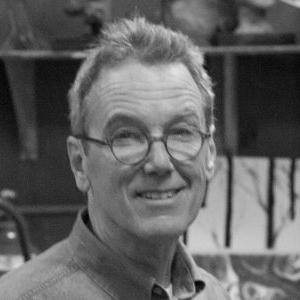Teaching art as part of a liberal education, as well as a discipline of its own, is important to Tim Segar. This led him to teach courses both across the arts, collaborating with music and theater faculty, and with teachers of history, anthropology and poetry. His teaching reflected the work he does in his own studio insofar as he spends a roughly equal time working in two and three dimensions. “The teaching of drawing is a partner to the teaching of sculpture. While sculpture proceeds slowly and technically, drawing can more nimbly seek ideas and forms.”
Teaching Philosophy
Tim says that the most delicate and important thing about teaching art is striking the right balance for students between information, inspiration, and permission. “Students of art need enough technique and process to act on their ideas. They also need to be inspired by the example of other artists—both historical and contemporary. They equally need permission to follow their own impulses and designs in order to test their work against the range of work they come to know. In the end that balance is a matter of paying attention to individuals and helping them find their own way.” Tim maintains that even though sculpture is a technical medium, so much can be learned from humble materials and simple techniques, using cardboard, clay, plaster and wood. “The development of a vocabulary of form is far more important, in the beginning, than a range of complex techniques,” he said. Tim welcomed students with Plans of Concentration in sculpture, installation art, video, printmaking, kinetic art, art from recycled materials, architecture, landscape design, sculpture-based photography, drawing and environmental studies. “I encourage inventiveness, the connection of subject matter to form and the developed sense of craft for all students who enter on Plan with me.”
Scholarly Activities
Tim has exhibited his work regularly throughout the Northeast, in California and in France. Tim showed his work at the Oxbow Gallery in Northampton, Massachusetts, in 2008, and at the Open Square in Holyoke, Massachusetts, in 2009. At the latter he presented work entitled “Almost Machines,” geared and wheeled sculptures that are kinetic, or appear to be. In 2010, Tim had an exhibit that used some of the same wood-bending techniques but presented forms that became surfaces on which to draw.
In 2007, Tim collaborated with theater professor Paul Nelsen and music professor Stan Charkey to initiate the Summer Arts Intensive program, a summer semester focused on experiential learning both here in Marlboro and in London. Over a period of seven weeks, students attended more than 80 museums, concerts, films, plays, operas, ballets and artists’ studios, culminating with independent projects in the medium of their choice.
In 2009, Tim led a trip to central Vietnam with several students to study the architecture, sculpture and culture of Champa, a Hindu kingdom prominent in the region for 16 centuries until the 1800s. Since returning he has lectured on this subject locally and in Northampton, Massachusetts.
Tim was hired by Marlboro College in 1998.
Education
B.F.A., Rhode Island School of Design
M.A., University of California at Berkeley
M.F.A., University of California at Berkeley
